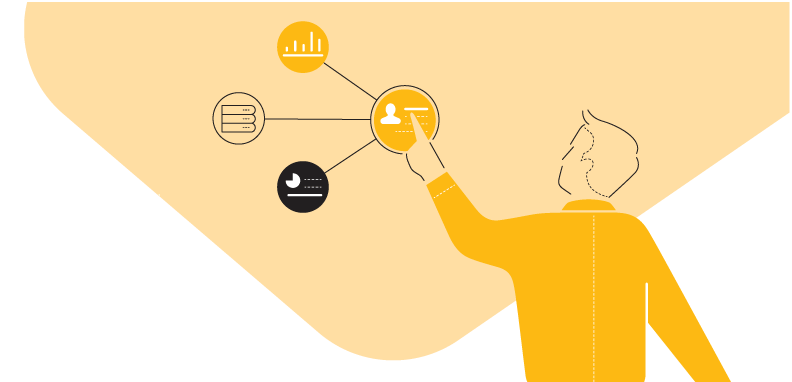In today’s competitive market, small-to-medium businesses (SMBs) must focus their efforts on reaching the right audience to stand out and grow. Targeted consumer data isn’t just a tool, it’s a game-changer that can empower you to identify, understand, and deeply connect with your ideal customers. Yet, despite the immense potential of incorporating consumer data into a marketing strategy, 87% of marketers believe their company is failing to fully leverage the value of its data, a missed opportunity that you can capitalize on to create more personalized marketing campaigns.
Understanding Targeted Consumer Data
Before going any further, we’d like to clearly define targeted consumer data.
Consumer data is the valuable information businesses gather about their customers. This data helps identify patterns, preferences, and behaviors that reveal who your customers are, and what they want. By using targeted consumer data, you can gain a deeper understanding of your target audience, helping you make informed marketing decisions.
Below are the key types of consumer data you can leverage for a more personalized marketing approach:
- Demographic data: Includes details like age, gender, income, education, and occupation
- Geographic data: Focuses on customer locations, such as city, state, or zip code
- Behavioral data: Tracks purchasing habits, website visits, and engagement with marketing channels
- Psychographic data: Explores customers’ lifestyles, values, and interests
- Technographic data: Examines the technology customers use, such as devices, apps, or platforms
For many SMBs, resources like time and marketing budgets are often limited, making intelligent marketing strategies an essential approach, and that starts with precise audience insights. Instead of casting a wide net and hoping for the best, making use of this data allows you to focus on the right audience, shifting from generic, one-size-fits-all campaigns to highly focused strategies that drive real growth.

Effective Customer Segmentation Techniques
So, what exactly is customer segmentation?
It’s the process of dividing consumer data into smaller, more manageable groups based on shared characteristics. This approach allows you to create personalized marketing campaigns that resonate with specific audiences, leading to higher engagement and improved return on investment (ROI).
Highlighting the value of personalized segmentation, a McKinsey study revealed that companies tailoring messaging to specific audience segments experienced accelerated revenue growth. Additionally, HubSpot reported that 65% of marketers saw improved email open rates when implementing segmented email campaigns.
At the foundation of customer segmentation are basic categories like:
- Demographic segmentation: Grouping customers by age, gender, income, education, and occupation
- Geographic segmentation: Grouping customers by their location: country, region, city, or even neighborhood
From there, you can dig even deeper with behavioral segmentation, which focuses on how customers interact with your brand, enabling you to better understand and predict their needs. Key behavioral segmentation includes:
- Purchase history: Identifying frequent buyers or customers who purchase specific product categories
- Website activity: Track browsing behavior, such as pages visited or time spent on the site, to identify high-intent visitors
- Engagement with marketing campaigns: Measure responses to email, ads, or social media posts to determine interest levels
- Usage patterns: Group customers by how they use your product or service: light users, heavy users, or seasonal buyers
- Loyalty behavior: Segment customers based on repeat purchases or referrals
- Feedback and reviews: Leverage customer feedback to identify common preferences or pain points
Additionally, you can utilize psychographic segmentation, which goes beyond “what” customers do, instead exploring “why” they do it. Essentially, this segmentation groups customers based on lifestyle, values, beliefs, hobbies, and interests. To create highly effective personalized campaigns, you’ll want to include psychographic segmentation into your data-driven marketing strategy.
With access to Data Axle USA’s segmented consumer data lists, you can reach your target audience with unmatched precision. These lists include information such as demographics, geographic data, industry, occupation, interests, education, and more.

Leveraging Consumer Data for Better Decision Making and Growth
Targeted consumer data is more than just numbers—it’s a roadmap to smarter decisions and growth strategies. Here’s how leveraging consumer data can inform your marketing strategy:
- Identify high-potential customer segments: Consumer data helps you focus on the customers most likely to engage or make a purchase. By analyzing demographics, behaviors, and preferences, you can focus on high-value segments and tailor your efforts to meet their needs.
- Identify high-potential customer segments: Consumer data helps you focus on the customers most likely to engage or make a purchase. By analyzing demographics, behaviors, and preferences, you can focus on high-value segments and tailor your efforts to meet their needs.
- Optimize marketing budgets: Data insights empower you to allocate resources more effectively. By identifying the channels and strategies that deliver the highest ROI, you can ensure every marketing dollar works harder.
- Predict future trends: Consumer data doesn’t just show past behaviors, it helps you anticipate what’s next. By analyzing patterns in customer behavior and historical data, you can identify emerging needs, adapt to changing preferences, and stay ahead of market trends. This proactive approach allows your business to remain competitive and meet customer expectations before they even realize them.
- Improve customer retention: Keeping existing customers is almost always more cost-effective than acquiring new ones. Data can reveal insights into customer satisfaction, enabling you to design loyalty programs and engagement strategies that resonate with your audience and encourage repeat business.
By harnessing the power of actionable consumer data, you can make informed decisions that fuel growth and drive results. With Data Axle USA as your partner, you’ll have access to reliable, precise data that supports your goals, from identifying high-potential customers to improving retention strategies.

Conclusion
Success in today’s business landscape is all about working smarter, not harder, and consumer data gives you the insights you need to do just that. By using this data, you can identify high-value customers, personalize your marketing efforts, and make data-driven decisions that spark success. Whether it’s optimizing marketing budgets or wanting to enhance ROI, consumer data empowers businesses to thrive in competitive landscapes.
At Data Axle USA, we make it easy for small and medium-sized businesses to access reliable, targeted, high-quality consumer data they can count on to grow. Whether it’s segmented lists or behavioral insights, our data helps you find the right audience, fine-tune your marketing campaigns, and focus on leads that really drive results.



